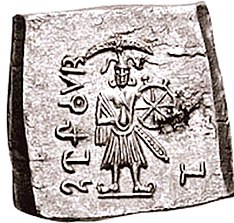| Part of a series on |
| Vaishnavism |
|---|
 |
The Bhagavata (Sanskrit: भागवत, romanised: Bhāgavata) tradition, also called Bhagavatism, refers to an ancient religious sect that traced its origin to the region of Mathura.[5] After its syncretism with the Brahmanical tradition of Vishnu, Bhagavatism became a pan-Indian tradition by the second century BCE, according to R.C. Majumdar.[6]
Historically, Bhagavatism corresponds to the development of a popular theistic movement in India, departing from the elitist sacrificial rites of Vedism,[7] and initially focusing on the worship of the Vrishni hero Vāsudeva in the region of Mathura.[1] It later assimilated into the concept of Narayana[8] where Krishna is conceived as svayam bhagavan. According to some historical scholars, worship of Krishna emerged in the 1st century BCE. However, Vaishnava traditionalists place it in the 4th century BCE.[9] Despite the relative silence of the earlier Vedic sources, the features of Bhagavatism and the principles of monotheism of Bhagavata school, as described in the Bhagavad Gita, are viewed as an example of the belief that Vāsudeva-Krishna is not an avatar of the Vedic Vishnu, but is the Supreme Being Himself.[10][11]
- ^ a b "A cult of Vāsudeva, known as Bhagavatism, was already in existence by the second century BC." in Srinivasan, Doris (1981). Kalādarśana: American Studies in the Art of India. BRILL. ISBN 978-90-04-06498-0.
- ^ Subburaj, V.V.K. (2004). Basic Facts of General Knowledge. Sura Books. pp. 67–68. ISBN 978-81-7254-234-4.
- ^ Singh, Upinder (2008). A History of Ancient and Early Medieval India: From the Stone Age to the 12th Century. Pearson Education India. p. 437. ISBN 978-81-317-1120-0.
- ^ Joshi, Nilakanth Purushottam (1979). Iconography of Balarāma. Abhinav Publications. p. 22. ISBN 978-81-7017-107-2.
- ^ Patel, Sushil Kumar (1992). Hinduism in India: A Study of Viṣṇu Worship. Amar Prakashan. p. 18. ISBN 978-81-85420-35-6.
- ^ Majumdar, R. C. (1 January 2016). Ancient India. Motilal Banarsidass. p. 172. ISBN 978-81-208-0435-7.
- ^ Sastri, K. a Nilakanta (1952). Age of the Nandas And Mauryas. pp. 304–305.
- ^ Beck, G. (2005). "Krishna as Loving Husband of God". Alternative Krishnas: Regional and Vernacular Variations on a Hindu Deity. ISBN 978-0-7914-6415-1. Retrieved 28 April 2008. Vishnu was by then assimilated with Narayana
- ^ Hastings 2003, pp. 540–42
- ^ Srinivasan, Doris (1997). Many heads, arms, and eyes: origin, meaning, and form of multiplicity in Indian art. Leiden: Brill. p. 134. ISBN 90-04-10758-4.
- ^ Gopal, Madan (1990). K.S. Gautam (ed.). India through the ages. Publication Division, Ministry of Information and Broadcasting, Government of India. p. 76.
